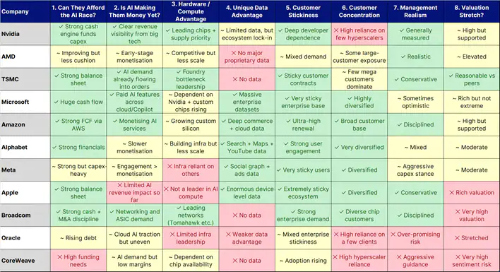AI’s Reality Check – Investors Now Demand Proof, Not Promises
Artificial intelligence remains one of the most powerful forces reshaping global markets, but the tone around the sector is shifting. While leading chipmakers continue to post impressive results, investors are no longer willing to accept growth narratives at face value.
The broad «everything goes up» phase of the AI trade is fading, Saxo Markets’ chief investment strategist, Charu Chanana, writes in a note issued on Tuesday. What is emerging instead is a more selective market environment, one that rewards operational strength and penalises inflated expectations.
Investors are beginning to differentiate between companies with robust fundamentals and those merely riding momentum. To address this shift, Chanana has put together an eight-factor framework for evaluating AI opportunities.
1. Understanding Who Can Compete Through Cycles
As AI becomes increasingly capital-intensive, companies must demonstrate they can afford the race. Infrastructure, energy, chips, and data-centre capacity require strong balance sheets.
Investors now scrutinise cash flow stability, debt levels, and self-funding capabilities to determine which players can endure both growth cycles and volatility, Chanana writes.
2. Revenue Must Prove AI’s Value
The era of AI demos and aspirational product videos is over. The market now expects concrete evidence of monetisation – from explicit AI-linked revenue to clear pricing strategies and customer willingness to pay. Companies investing ahead of monetisation risk margin pressure and heightened earnings scrutiny.
3. Infrastructure as a Competitive Edge
In AI, physical scale matters. Companies with access to scarce chips, power, land, and cooling infrastructure hold a growing advantage. Supply constraints or delays in expanding capacity can quickly derail earnings trajectories.
4. Data Is Becoming the New Moat
As models converge in capability, proprietary data is emerging as a core differentiator. Firms with exclusive datasets, large user bases, or strategic partnerships are better positioned to defend their competitive edge.
5. The Power of Customer Stickiness
Recurring revenue and high renewal rates are becoming critical indicators of long-term viability. Investors are watching not just for customer retention, but for increased engagement following AI rollouts – a sign that AI products deliver genuine value.
6. Concentration Risk in the AI Supply Chain
Many suppliers remain heavily dependent on a few large hyperscalers, creating meaningful earnings risk. When 20 to 50 percent of revenue comes from only one or two customers, even a minor spending pause can create significant volatility. Investors increasingly expect diversified demand and multi-industry penetration.
7. Expectations Must Match Reality
Markets now reward measured guidance and credible execution. Shifting timelines and missed targets raise credibility concerns, especially in a sector where valuations often assume near-perfect outcomes.
8. When Valuations Price in Perfection
With elevated multiples across key AI names, any disappointment can trigger outsized reactions. Higher-for-longer rates amplify this sensitivity, forcing investors to assess whether prices already reflect ambitious earnings forecasts.
Navigating the Next Phase
(Click to enlarge)
Chanana’s eight-factor framework provides a clear and structured approach to evaluating companies within the evolving AI ecosystem. While the technology undoubtedly represents a multi-year growth cycle, the next stage may reward firms that pair innovation with financial strength, operational discipline, and diversified demand.
«The opportunity is real, but so are the risks. Investors need a sharper lens to separate durable AI leaders from those fuelled mostly by momentum,» concludes the Saxo specialist.





























